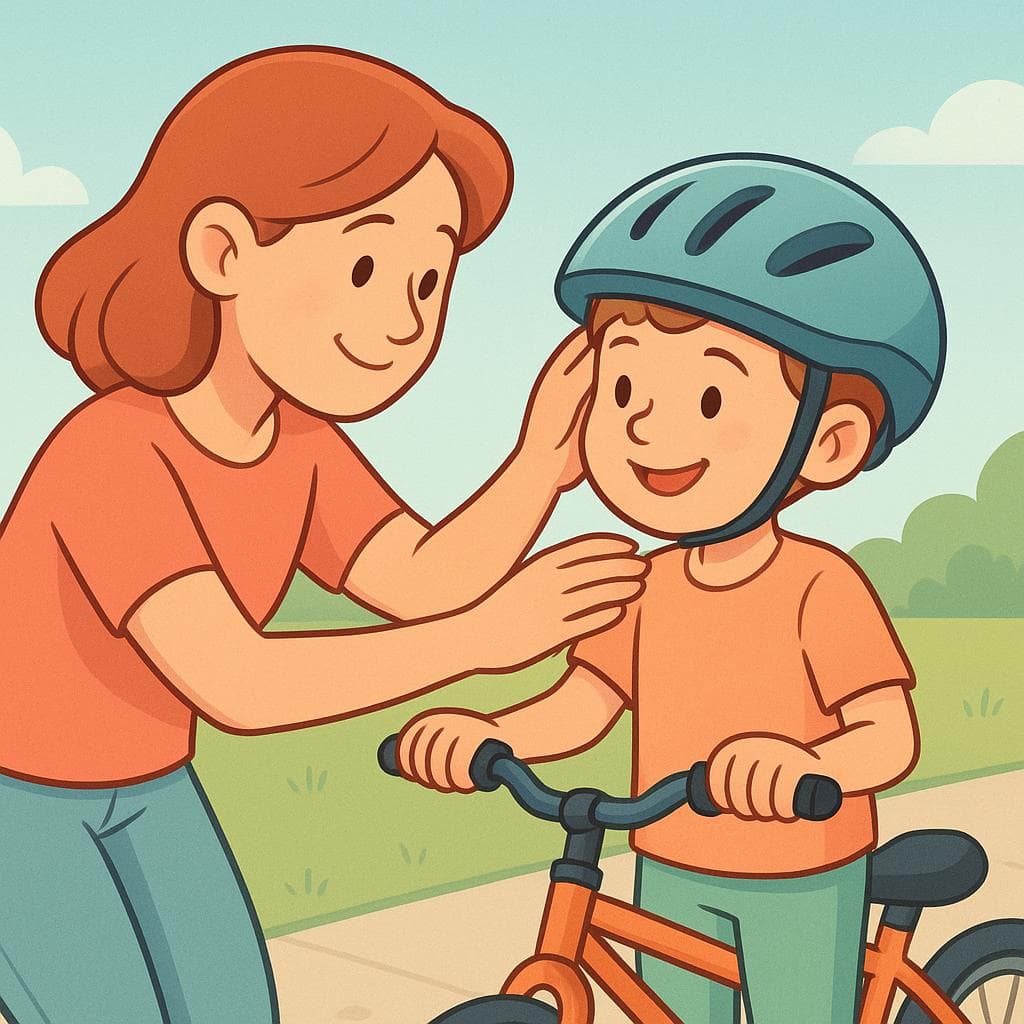Be careful
in SpanishTen cuidado
/ten kwee-DAH-doh/
This is the most common and direct way to tell someone to be careful. It's the informal 'tú' command, so you use it with friends, family, children, and people you know well.

Expressing care and concern, like telling someone 'Ten cuidado', is a fundamental part of daily life in Spanish.
💬Other Ways to Say It
Tenga cuidado
/TEN-gah kwee-DAH-doh/
This is the formal 'usted' version of 'Ten cuidado'. It carries the same meaning but shows respect.
Cuídate
/KWEE-dah-teh/
This literally means 'Take care of yourself'. It's a warmer, more personal way to say 'be careful' and is extremely common as a way to say goodbye.
¡Cuidado!
/kwee-DAH-doh/
A short, urgent exclamation meaning 'Careful!' or 'Watch out!'. It's used to warn someone of immediate danger.
¡Ojo!
/OH-hoh/
Literally meaning 'Eye!', this is a very common and colloquial way to say 'Watch out!' or 'Heads up!'. It's often accompanied by pointing a finger to your own eye.
Tengan cuidado
/TEN-gahn kwee-DAH-doh/
This is the plural form, used when speaking to more than one person. In Latin America, it's used for any group; in Spain, it's the formal plural ('ustedes').
¡Aguas!
/AH-gwahs/
A very common, informal warning in Mexico that means 'Watch out!'. Literally 'Waters!', its origin comes from the practice of shouting this before throwing dirty water out of a window into the street.
Anda con cuidado
/AHN-dah kon kwee-DAH-doh/
This translates to 'Walk with care' or 'Go carefully'. It's a slightly softer, more gentle suggestion than the direct command 'Ten cuidado'.
Tené cuidado
/teh-NEH kwee-DAH-doh/
This is the 'voseo' version of 'Ten cuidado'. The 'vos' pronoun is used instead of 'tú' in these regions, which changes the verb form and shifts the stress.
🔑Key Words
Key Words to learn:
📊Quick Comparison
Choosing the right way to say 'be careful' depends on who you're talking to and the situation. Here's a quick comparison:
| Phrase | Formality | Best For | Avoid When |
|---|---|---|---|
| Ten cuidado | Informal | Everyday instructions to friends, family, or children. | Speaking to strangers, elders, or your boss. |
| Tenga cuidado | Formal | Showing respect in professional or formal settings. | Chatting casually with a close friend (it would sound stiff). |
| Cuídate | Informal | A warm and friendly way to say goodbye. | Warning someone of immediate, sudden danger. |
| ¡Cuidado! / ¡Ojo! | Neutral/Informal | Quick, urgent warnings about a potential hazard. | A gentle, non-urgent goodbye (use 'Cuídate' instead). |
📈Difficulty Level
The 'kwee' sound in 'cuidado' can be a little tricky for English speakers at first, but it's very consistent. The rest is straightforward.
This phrase uses the imperative mood (commands), which means you need to know the correct form for who you're talking to (tú, usted, ustedes, vos). This adds a layer of complexity.
Understanding formality (ten vs. tenga) is crucial. Also, knowing regionalisms like '¡Aguas!' or '¡Ojo!' and their associated gestures will make you sound much more natural.
Key Challenges:
- Remembering the formal (tenga) vs. informal (ten) command.
- Knowing when to use 'Ten cuidado' vs. 'Cuídate'.
💡Examples in Action
Ten cuidado al cruzar la calle, mira a ambos lados.
Be careful when you cross the street, look both ways.
El piso está mojado. ¡Tenga cuidado, por favor!
The floor is wet. Please be careful!
Bueno, me voy a casa. ¡Hablamos mañana!
Okay, I'm heading home. We'll talk tomorrow!
¡Ojo con ese vendedor! A veces sus precios son muy altos.
Watch out for that vendor! Sometimes his prices are very high.
Chicos, el sendero es resbaladizo. Tengan cuidado.
Guys, the trail is slippery. Be careful.
🌍Cultural Context
A Sign of Caring, Not Bossiness
In English, giving a direct command like 'Be careful' can sometimes sound a bit bossy. In Spanish, saying 'Ten cuidado' to friends and family is a very common and natural expression of affection and concern. It's seen as looking out for someone you care about.
The 'Ojo' Gesture
When someone says '¡Ojo!', they will often use their index finger to pull down the skin just below one of their eyes. This gesture reinforces the message of 'keep an eye out' or 'pay attention'. It's a piece of body language that's universally understood in the Spanish-speaking world.
The Story of '¡Aguas!'
The Mexican expression '¡Aguas!' is a fantastic piece of living history. It dates back to colonial times when homes didn't have indoor plumbing. People would throw buckets of dirty water (aguas sucias) out of their windows onto the street, shouting '¡Aguas!' to warn pedestrians below. The warning stuck, even though the practice has (thankfully) stopped.
❌ Common Pitfalls
Mixing Up Formality
Mistake: "Saying 'Ten cuidado' to your new boss or an elderly person you've just met."
Correction: Tenga cuidado
Confusing 'To Be' and 'To Have'
Mistake: "Trying to translate literally and saying 'Sé cuidadoso' (Be careful - as a personality trait)."
Correction: Ten cuidado
Using 'Cuídate' for Urgent Warnings
Mistake: "Shouting '¡Cuídate!' as a car speeds towards your friend."
Correction: ¡Cuidado!
💡Pro Tips
Make 'Cuídate' Your Go-To Goodbye
Adding 'Cuídate' to the end of a conversation is an incredibly natural and friendly way to say bye. It works in person, on the phone, or in texts. Phrases like 'Adiós, ¡cuídate!' or 'Hablamos luego, cuídate mucho' are perfect for daily use.
Soften the Command if Needed
Although 'Ten cuidado' isn't considered rude, you can soften it to sound extra polite or gentle. Just add 'por favor' (please) or 'mucho' (a lot): 'Ten mucho cuidado en el viaje' (Be very careful on the trip).
Listen for Intonation
The meaning of '¡Cuidado!' can change with your tone of voice. A sharp, loud '¡CUIDADO!' is an urgent warning. A softer, gentler 'Cuidado...' can mean something more like 'Careful now...' as you watch someone handle a fragile object.
🗺️Regional Variations
Mexico
The use of '¡Aguas!' is the most distinctive feature. It's an extremely common, almost reflexive warning for any kind of impending trouble, from a car coming to a spilled drink. 'Ten cuidado' is used for more general advice.
Spain
The key difference is the use of 'vosotros' for informal plural, leading to 'Tened cuidado'. This form is not used in Latin America. The expression 'Anda con ojo' is also quite common for general cautiousness.
Argentina & Uruguay
The 'voseo' is the defining characteristic. The command form for 'vos' is 'tené', which is used in all informal situations instead of 'ten'. This is a critical marker of the Rioplatense dialect.
📱Texting & Social Media
cuídate
Used in WhatsApp, SMS, and social media chats as a quick, friendly sign-off.
Hablamos mañana, cdt!
Talk tomorrow, take care!
💬What Comes Next?
After you tell someone 'Ten cuidado'
Gracias, lo tendré.
Thanks, I will.
De nada. ¡Que te vaya bien!
You're welcome. Hope it goes well for you!
When you say 'Cuídate' as a goodbye
Tú también, cuídate.
You too, take care.
¡Gracias!
Thanks!
After you shout '¡Cuidado!' to warn them
¡Uf, gracias! Casi me caigo.
Phew, thanks! I almost fell.
¿Estás bien?
Are you okay?
🔄How It Differs from English
The biggest difference is cultural. In Spanish, issuing a direct command like 'Ten cuidado' is a very common way to show you care. In English, we often soften this with phrases like 'You should probably be careful' or 'Just watch out for...', as direct commands can feel aggressive. In Spanish, this directness among loved ones is normal and expected.
False Friends & Common Confusions:
Why it's different: English uses 'to be' for both the instruction ('Be careful!') and the personality trait ('He is a careful person'). Spanish uses two different structures.
Use instead: For the instruction, use 'Tener cuidado'. For the personality trait, use 'Ser una persona cuidadosa' or simply 'Ser cuidadoso'.
🎯Your Learning Path
➡️ Learn Next:
How to say Don't worry
This is a natural response when someone tells you to be careful, as in 'Don't worry, I will be'.
How to say Take care
This is a close relative of 'be careful' and explores the different uses of the verb 'cuidar'.
How to say Watch out
This focuses specifically on the urgent warning aspect, diving deeper into phrases like '¡Cuidado!' and '¡Ojo!'.
How to give advice in Spanish
Learning 'be careful' is your first step into giving advice and commands. This will broaden that skill.
✏️Test Your Knowledge
💡 Quick Quiz: Be careful
Question 1 of 4
You are at a supermarket and see an elderly man about to slip on a wet spot. What is the most appropriate thing to shout?
Frequently Asked Questions
What's the real difference between 'Ten cuidado' and 'Cuídate'?
Think of it this way: 'Ten cuidado' is an instruction for a specific situation, like 'Be careful, that pan is hot.' 'Cuídate' is a general wish for someone's well-being, usually used when saying goodbye, like 'Take care of yourself.'
Is it rude to say 'Ten cuidado' to someone?
Not at all, as long as you're using it with the right person! With friends, family, and peers (anyone you call 'tú'), it's a perfectly normal and caring thing to say. It would only be rude if you used this informal version with someone who requires formal address, like an elderly stranger or your CEO.
How do I tell a whole group of people to be careful?
You use the plural form, 'Tengan cuidado'. This works for any group in Latin America. In Spain, you would use 'Tengan cuidado' for a formal group and 'Tened cuidado' for an informal group of friends.
What does '¡Ojo!' actually mean and why do people point to their eye?
'Ojo' literally means 'eye'. As an exclamation, it means 'Watch out!' or 'Pay attention!'. Pointing to the eye is a non-verbal cue that reinforces the message, as if to say 'Use your eyes!' or 'Keep an eye on this.' It's a very common gesture-and-word combination.
I'm going to Argentina. Should I say 'Ten cuidado' or something else?
In Argentina, you should use the 'vos' form, which is 'Tené cuidado' (with the stress on the 'ne'). While they will understand 'Ten cuidado', using 'Tené' will make you sound much more like a local and show you've done your homework on their specific dialect.
Can I use 'Cuidado' by itself?
Yes, absolutely! Shouting '¡Cuidado!' on its own is the most common way to warn someone of immediate danger. It's a quick, universal alert that everyone understands.
📚Continue Learning Spanish Phrases
Explore More Phrases in These Categories
Find similar phrases to expand your Spanish vocabulary:
Want to Learn More Spanish Phrases?
Browse our complete collection of Spanish phrases organized by situation, from basic greetings to advanced conversations. Perfect for travelers, students, and anyone learning Spanish.
View All Spanish Phrases →
